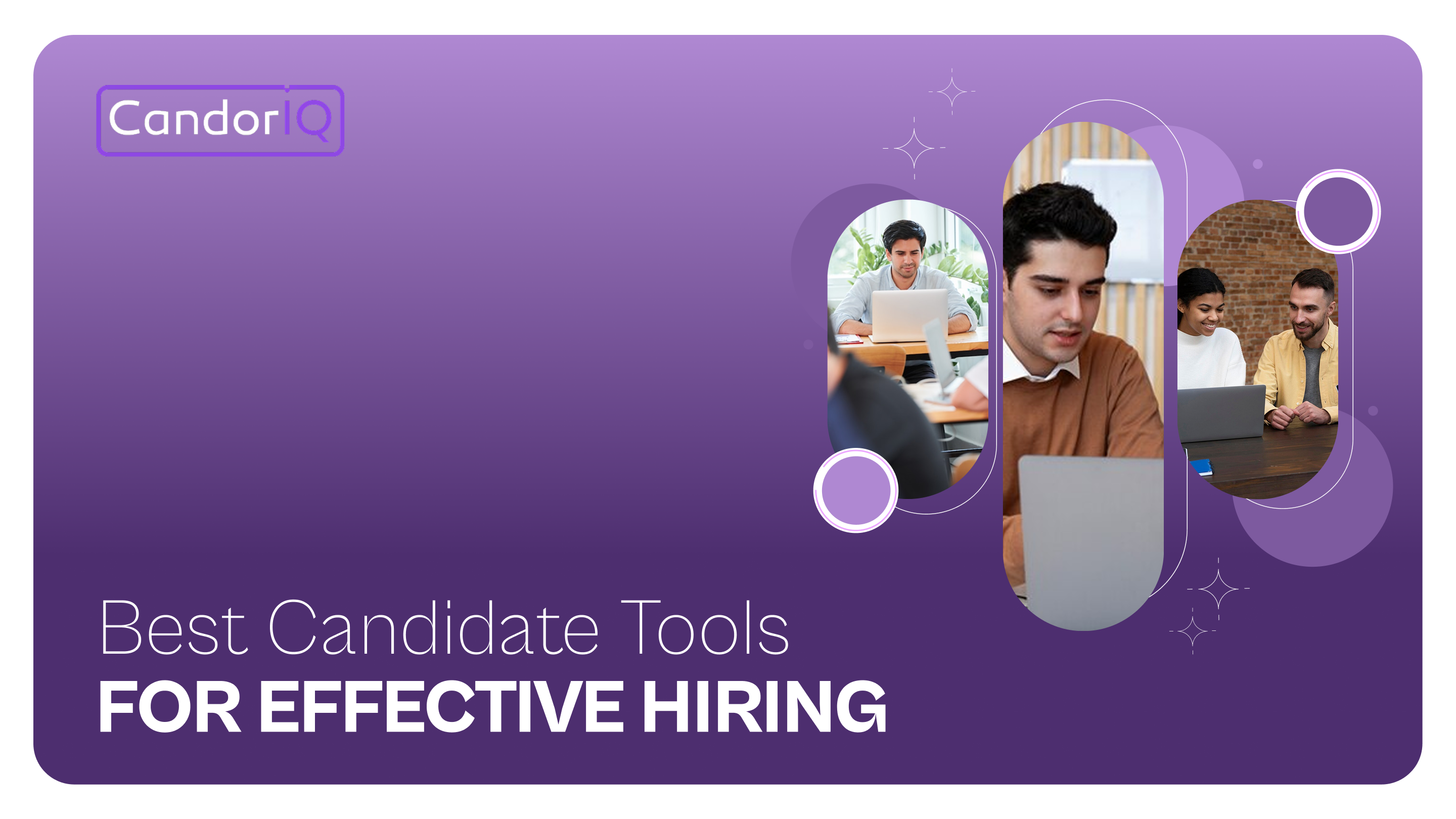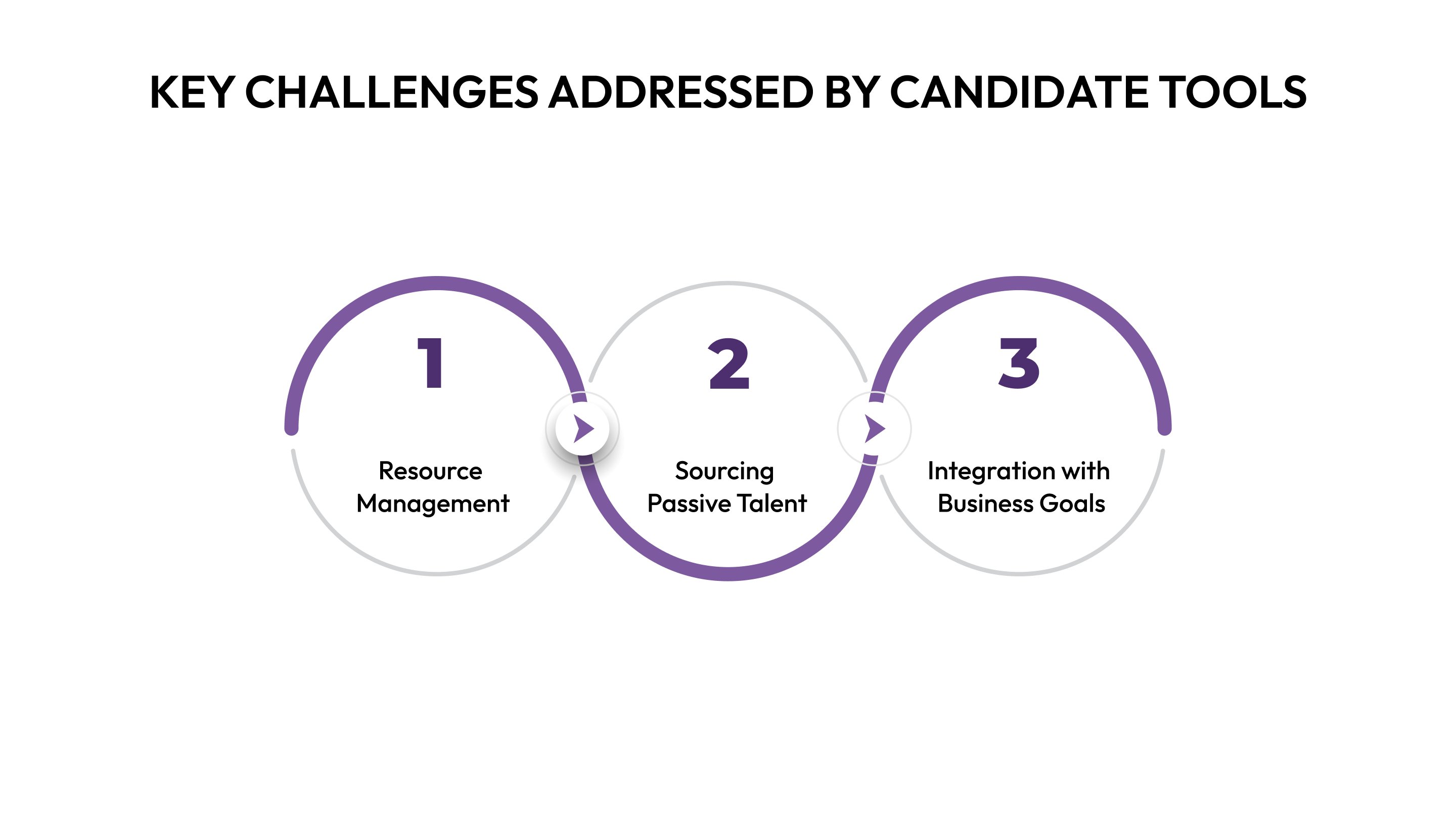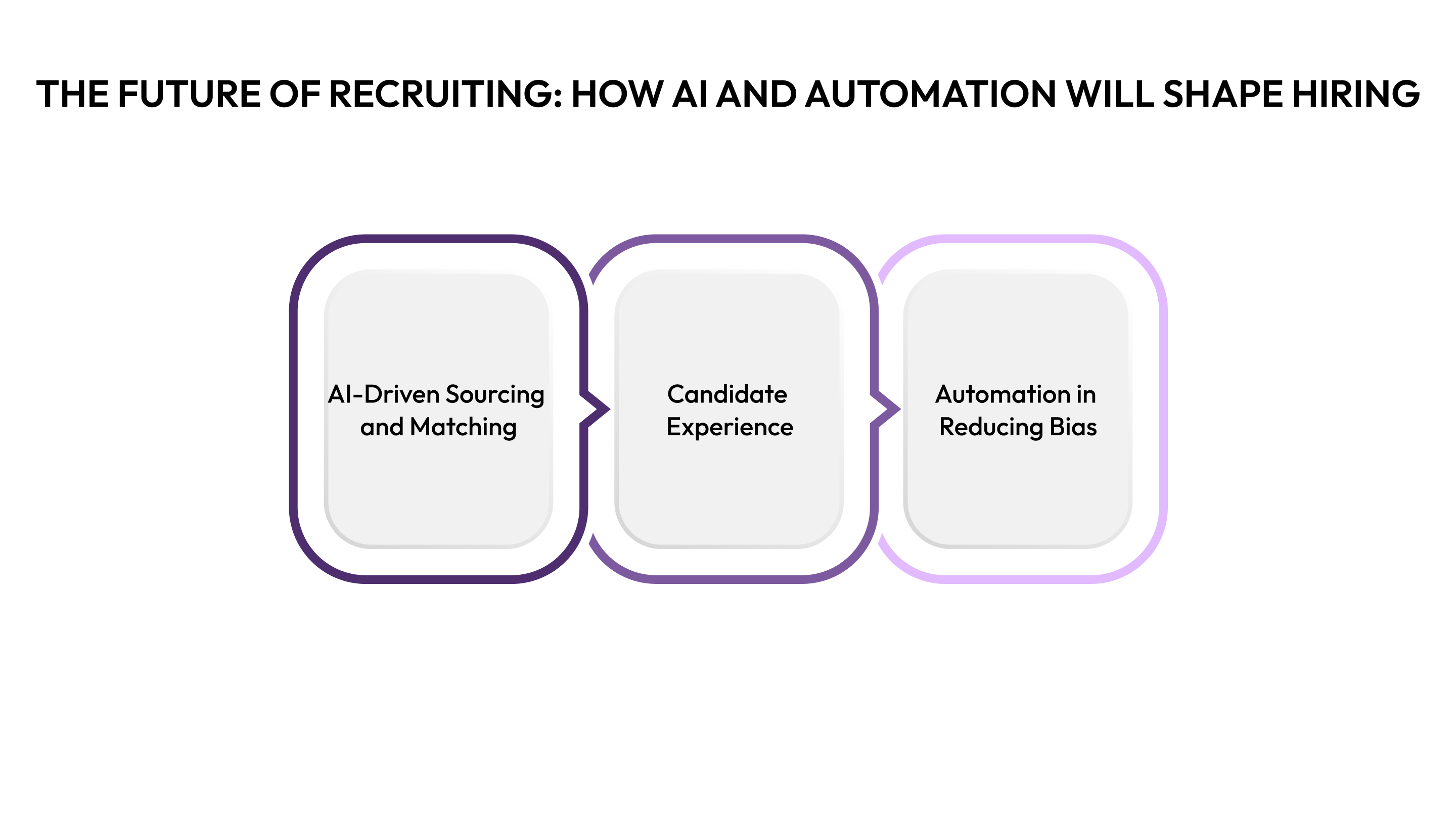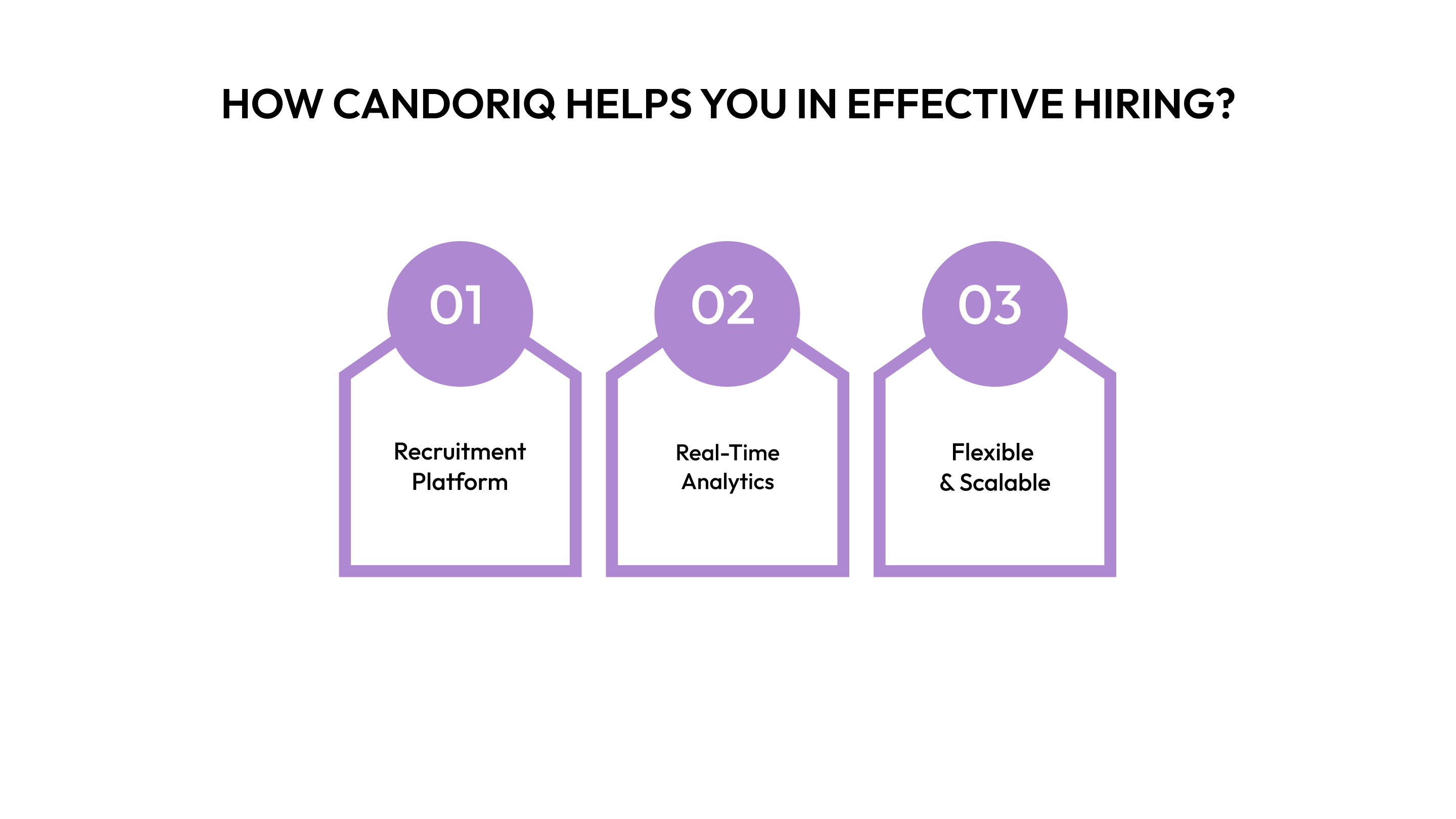Best Candidate Tools for Effective Hiring
Discover the top candidate tools to streamline hiring, improve sourcing, and enhance recruitment decisions. Read more.

Traditional recruitment methods often fall short in meeting the demands of fast-paced hiring environments. This is where candidate tools play a very important role in an effective and smooth hiring process.
Candidate tools are nothing but advanced software solutions designed to enhance the overall recruitment process. These tools use technologies such as artificial intelligence, automation, and data analytics to help HR teams source, screen, and manage candidates more efficiently.
Compelling statistics highlight the significance of candidate tools. A study by SHRM found that 85% of employers using automation or AI report increased efficiency and time savings, with 86.1% of recruiters stating that AI accelerates the hiring process.
Key Takeaways
- Candidate tools automate sourcing, screening, and communication, saving time for HR teams.
- AI-driven analytics help make data-informed hiring decisions and reduce bias.
- Modern tools enhance candidate experience while supporting equitable compensation.
- Integrated platforms like CandorIQ provide end-to-end recruitment solutions.
- Choosing the right candidate tools is essential for scaling hiring operations efficiently.
Why Candidate Tools Are Important for HR Operations
As your organization expands, especially in a fast-growth environment, HR teams often become overwhelmed with the increased hiring volume. Candidate tools help you overcome these situations. Here’s why you should use them:
- Efficiency: Automates tasks like screening resumes, scheduling interviews, and posting jobs, which reduces the workload for HR teams and speeds up the recruitment process.
- Better Candidate Experience: Tools help communicate with candidates more effectively, ensuring they get timely updates, which improves their experience with your company.
- Cost-Effective: Reduces the time spent on manual processes, cutting down on the costs associated with recruiting.
Also Read: From Data to Influence: How Compensation Pros Are Future-Proofing Their Roles
Key Challenges Addressed by Candidate Tools

Candidate tools help you resolve major issues, such as saving time and resources, improving hiring efficiency, and ultimately leading to better recruitment outcomes. For fast-growing companies, they’re no longer optional; they’re essential for scaling efficiently.
- Resource Management: Scaling businesses often face limited HR resources. Candidate tools automate repetitive tasks, allowing small HR teams to manage a larger volume of recruitment needs without additional hires.
- Sourcing Passive Talent: Finding the right talent isn’t just about candidates applying for open roles. These tools help identify and engage passive candidates—individuals who aren’t actively seeking a job but could be a good fit for your company.
- Integration with Business Goals: For CFOs and People Ops leaders, understanding the cost and impact of each new hire is critical. Candidate tools can provide valuable data to help you balance recruitment costs and talent needs with your overall budget and growth goals.
As recruitment needs evolve, it's necessary to understand which features of candidate tools can directly support your growth strategy and improve hiring outcomes.
The Core Features to Look for in Effective Candidate Tools

The right candidate tools should be equipped with specific features to ensure efficiency and quality in the recruitment process. These features are essential for optimizing candidate sourcing, improving the candidate experience, and ultimately securing the best talent.
Here are the core features that matter most:
1. AI-Powered Candidate Sourcing
Tools should use AI to scan job boards, LinkedIn, and other platforms for top talent that closely aligns with your job requirements. This allows you to tap into a broader talent pool and identify candidates quickly and efficiently.
2. Automated Screening and Assessments
Look for tools that automatically assess resumes, skills, and experience to help you identify the best candidates right away. This automation reduces manual screening efforts, allowing teams to focus on high-quality candidates.
3. Talent Pool Management and Collaboration
Candidate tools with tagging and group collaboration features allow your team to work together in a more organized way. These tools make it easier to manage candidate information, track progress, and share insights across departments.
4. Real-Time Reporting and Analytics
Having access to real-time reports helps your team understand how well sourcing efforts are performing. Data-driven insights allow you to refine your hiring strategies, ensuring you're making the best decisions at every stage of the recruitment process.
Also Read: Compensation and Benefits: Essential Concepts Explained
To help you make informed decisions, let's explore the candidate tools that can help you drive smarter talent acquisition strategies.
10 Candidate Tools That Can Transform Your Recruitment Process
Finding the right talent quickly and efficiently is a constant challenge for recruitment teams. The right candidate tools can significantly improve the speed and accuracy of your hiring process. By automating sourcing, screening, and engagement, these tools help reduce manual effort and ensure a more effective recruitment strategy.
Here are the best candidate tools designed to support your recruitment goals.
1. CandorIQ
CandorIQ is designed to simplify talent acquisition by integrating with their ATS to help manage the candidate offer process and keep the headcount offers in mind with overall budgeting. It allows for smarter decision-making and offers valuable insights into compensation and workforce planning.
Moreover, CandorIQ addresses the needs of budget-sensitive CFOs who require predictability in workforce costs.
Key Features:
- AI-Powered Matching: Aligns candidates’ profiles with job descriptions using AI.
- Geo-Adjusted Salary Management: Customize compensation to location to ensure fair pay practices.
- Integrated Talent Pool Management: Allows for efficient tracking of candidate engagement and progress.
2. Greenhouse
Greenhouse is a popular applicant tracking system (ATS) that optimizes the hiring process by focusing on the candidate experience. It integrates seamlessly with job boards and social media platforms, offering a customizable workflow that fits every organization’s needs.
Key Features:
- Customizable Workflows: Allows organizations to tailor hiring processes to their specific needs.
- In-Depth Reporting: Provides valuable insights into hiring performance, helping HR teams adjust strategies.
- Advanced Integrations: Supports integration with job boards, social media, and other HR tools to broaden sourcing reach.
3. SeekOut
SeekOut is ideal for organizations that need specialized and hard-to-find talent, particularly in technical and security clearance roles. This tool helps businesses tap into passive talent pools with advanced search filters and AI-powered recommendations.
Key Features:
- Advanced Search Filters: Allows recruiters to find candidates based on specific qualifications like security clearance.
- Diversity Sourcing: Helps companies improve diversity hiring by searching through underrepresented candidate pools.
- AI-Driven Recommendations: Uses AI to recommend candidates who fit best based on past hiring patterns.
4. Manatal
Manatal is an AI-powered recruitment tool that automates candidate sourcing and matching. It centralizes recruitment activities across job boards, social media, and career pages to make it easy for HR teams to find the best candidates quickly.
Key Features:
- AI-Powered Candidate Matching: Automatically matches candidates with job requirements based on profiles.
- CRM Integration: Helps streamline communication and track relationships with candidates.
- Resume Parsing: Automatically parses resumes to create structured candidate profiles, saving time during the screening process.
5. Jobvite
Jobvite is an applicant tracking system (ATS) that helps companies build talent pools, track applicants, and manage the entire recruiting lifecycle. It focuses on improving the hiring process by simplifying sourcing, screening, and interviewing.
Key Features:
- Talent Pool Management: Helps manage relationships with both active and passive candidates.
- Smart Scheduling: Automates interview scheduling to reduce time spent on administrative tasks.
- In-depth Analytics: Offers reporting tools to evaluate the effectiveness of recruitment campaigns.
6. Lever
Lever is a collaborative ATS that enhances teamwork and efficiency by allowing multiple stakeholders to participate in the hiring process. It integrates with various tools and provides valuable insights for decision-making.
Key Features:
- Collaborative Hiring: Allows teams to work together seamlessly, improving decision-making.
- Advanced Reporting: Provides data-driven insights to help optimize recruiting strategies.
- Candidate Relationship Management (CRM): Supports continuous engagement with top talent.
7. HireEZ
HireEZ is a recruitment tool that uses AI to help recruiters find and engage top-tier talent. It provides access to a vast database of profiles and integrates with ATS and CRM systems, improving efficiency and candidate engagement.
Key Features:
- CRM Capabilities: Organizes candidate data and tracks communications to improve follow-ups.
- Multi-Channel Outreach: Uses email, SMS, and social media to engage with candidates across multiple platforms.
- Candidate Rediscovery: Helps find and engage candidates from previous hiring campaigns.
8. SmartRecruiters
SmartRecruiters offers a modern, user-friendly ATS that helps companies manage the entire recruiting process. With its focus on collaboration, it enables teams to engage better with candidates and improve hiring efficiency.
Key Features:
- Collaborative Hiring: Facilitates teamwork by involving hiring managers and HR teams in the decision-making process.
- Mobile-Friendly: Allows teams and candidates to stay connected on the go.
- Advanced Analytics: Tracks hiring performance and provides insights for strategy improvement.
9. Workable
Workable is a robust recruitment tool that simplifies hiring by combining an ATS with candidate sourcing features. It allows for easy job posting, candidate management, and tracking.
Key Features:
- Customizable Job Listings: Makes it easy to post jobs across multiple platforms.
- AI-Powered Recommendations: Suggests suitable candidates based on job descriptions and past hiring data.
- Interview Scheduling: Allows candidates and recruiters to schedule interviews directly within the platform.
10. Breezy HR
Breezy HR is an easy-to-use, end-to-end recruiting platform that helps companies manage the hiring pipeline from job posting to offer acceptance. It’s especially useful for small to mid-sized businesses looking to optimize their recruitment process.
Key Features:
- Pipeline Management: Helps track candidates through every stage of the hiring process.
- Candidate Engagement: Automated communication ensures candidates are kept in the loop throughout the process.
- Referral Program Integration: Helps manage and track employee referrals, improving candidate sourcing.
Each tool offers unique features that support the specific needs of HR and recruitment teams, making it easier for companies to scale their hiring efforts and make data-driven decisions.

Also Read: Effective Applications of HR Analytics in Performance Optimization
The focus is shifting towards enhancing both efficiency and fairness, with AI and automation leading the charge in shaping the future of hiring.
The Future of Candidate Tools: How AI and Automation Will Shape Recruiting

As technology advances, AI and automation are changing the way recruitment works. These innovations are making hiring faster, smarter, and more inclusive, improving both the process and the results for organizations of all sizes.
In the future, recruitment tools will become more intelligent, driving better talent discovery and offering a more personalized experience for candidates.
1. AI-Driven Sourcing and Matching
AI algorithms are becoming the backbone of candidate sourcing and matching. By analyzing resumes, job descriptions, and previous hiring data, AI can recommend the best candidates, often faster than a human recruiter could.
These tools use machine learning to continuously improve their suggestions, ensuring that the right candidates are identified, even from large pools. The result is a more efficient hiring process, where the time spent on manual sourcing and reviewing is minimized.
Key benefits of AI-driven sourcing:
- Faster Matching: AI identifies qualified candidates quickly, reducing the time spent reviewing resumes.
- Better Accuracy: By learning from past hiring decisions, AI can improve its matching capabilities over time, identifying candidates who are more likely to succeed in the role.
2. The Shift Toward Candidate Experience
In an increasingly competitive job market, candidate experience is becoming a major differentiator. Modern recruitment tools are moving beyond simple automation to focus on creating a positive, personalized experience for each applicant.
This includes keeping candidates informed throughout the hiring process, providing timely feedback, and ensuring that the application process is user-friendly. Tools that focus on candidate engagement help businesses not only attract top talent but also improve their employer brand.
Key elements of an improved candidate experience:
- Timely Communication: Automated updates and reminders keep candidates in the loop, improving their overall experience.
- Ease of Use: Simplified application processes, especially mobile-friendly ones, allow candidates to apply with minimal effort.
3. The Role of Automation in Reducing Bias
Bias in recruitment has long been a challenge, but automation, particularly when combined with AI, has the potential to reduce unconscious bias. Automated systems can remove identifying information like names or gender from applications, ensuring that hiring decisions are based solely on qualifications and experience. As automation tools become smarter, they can further support diversity and inclusion initiatives by recommending diverse candidates or highlighting areas where diversity may be lacking.
How automation helps reduce bias:
- Objective Decision-Making: Automated systems ensure that hiring decisions are based on candidate data and not influenced by unconscious bias.
- Increased Diversity: Automation can prioritize diversity and inclusion by focusing on qualifications and experience, leading to a more balanced candidate pool.
By focusing on both efficiency and candidate experience, these tools will help businesses stay competitive and attract the best talent in the market.
Tools like CandorIQ can make a real difference for HR teams. It gives you a clearer picture of your talent strategy. This tool is worth considering as it can truly ease the load on your team and help you make smarter, more efficient hiring decisions. Let’s get into the details of how.
.png)
How CandorIQ Helps You in Effective Hiring?

CandorIQ stands out as a comprehensive recruitment solution with features that go beyond just sourcing candidates. It offers a powerful, integrated platform that streamlines every aspect of the hiring and retention process. Here’s why CandorIQ can be the right choice for your HR needs:
Key Features:
- End-to-End Recruitment Platform: CandorIQ provides an all-in-one solution for recruitment, compensation, and talent retention. It simplifies the entire process, from sourcing and screening candidates to managing compensation and ensuring compliance with compensation laws.
- Real-Time Analytics: With CandorIQ, you gain access to real-time insights into your recruitment performance. The platform’s analytics tools give you the ability to track candidate sourcing effectiveness, hiring velocity, and budget utilization.
- Flexible & Scalable: Whether you’re a fast-growing startup or an established organization, CandorIQ scales with your needs. Its flexible features allow it to adapt to changing business demands, offering consistent value as your team expands.
CandorIQ offers a comprehensive solution that not only streamlines the hiring process but also fosters employee retention through fair compensation and data-driven insights.
Final Thoughts
As recruitment continues to evolve, the importance of AI-powered candidate tools cannot be overstated. These tools not only automate time-consuming tasks but also enable smarter, data-driven decision-making. This makes it easier to find and hire the best talent.
With tools like CandorIQ, you can get the right support to optimize your recruitment strategies and enhance the overall hiring process.
Start improving your hiring process today by scheduling a demo with CandorIQ. Experience the power of AI-driven insights, geo-adjusted compensation, and seamless integration to make smarter, faster hiring decisions.
FAQ’s
Q1. How can candidate tools help in hiring niche or passive talent?
A1. Candidate tools use AI-driven sourcing to identify candidates who may not be actively applying for jobs but fit your requirements perfectly. This helps HR teams reach passive talent quickly, reducing reliance on traditional job postings and expanding the pool of high-quality candidates.
Q2. Can candidate tools integrate with existing HR systems and workflows?
A2. Yes, modern candidate tools often offer integrations with ATS, CRM, and payroll systems. This ensures seamless data flow, avoids duplicate entries, and allows HR teams to maintain efficiency while leveraging AI-powered sourcing and analytics.
Q3. How do candidate tools support diversity and inclusion initiatives?
A3. Many candidate tools have features that reduce unconscious bias by anonymising applications and prioritising skill-based evaluations. Some tools also provide insights on diversity metrics, helping HR leaders make fairer hiring decisions and improve workplace inclusivity.
Q4. Are candidate tools useful for small or growing businesses with limited HR resources?
A4. Absolutely. Candidate tools automate repetitive tasks like resume screening, interview scheduling, and candidate communication. This allows small HR teams to manage higher hiring volumes efficiently without needing additional resources.
Q5. How do candidate tools improve the overall candidate experience?
A5. Candidate tools provide timely updates, automated reminders, and a smooth application process. They ensure candidates feel informed and valued, which not only strengthens employer branding but also increases the likelihood of attracting top talent.


